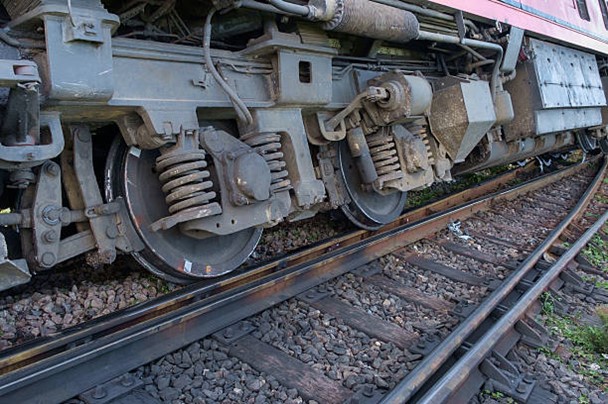
Train derailments can be catastrophic, causing severe injuries, loss of life, and extensive property damage. While train travel is generally safe, derailments still occur due to a variety of factors, from mechanical failures to human error. Understanding the most common causes of train derailments can help prevent future accidents and ensure accountability when negligence plays a role.
What Causes Train Derailments?
A train derailment happens when a train comes off its tracks, often leading to crashes, fires, and hazardous material spills. The Federal Railroad Administration (FRA) reports that derailments are responsible for millions of dollars in damages each year.
The Top Causes of Train Derailments
- Track Defects – One of the leading causes of derailments, broken rails, misaligned tracks, and switch failures can cause trains to jump off their tracks. Poor maintenance increases these risks.
- Mechanical Failures – Malfunctioning brakes, wheel defects, or issues with the locomotive engine can contribute to derailments. Routine inspections are critical to preventing mechanical breakdowns.
- Human Error – Train operators must follow strict speed limits, braking procedures, and track-switching protocols. Mistakes in operation or miscommunication between conductors and rail controllers can lead to derailments.
- Speeding – Excessive speed, especially around curves or in areas with poor track conditions, increases the likelihood of derailments. Many past derailments have been linked to trains traveling above recommended speeds.
- Obstructions on the Tracks – Fallen trees, vehicles at crossings, debris, and even animals on the tracks can force a train off its rails. Railroad companies must ensure tracks are clear and visible.
- Defective Train Components – Faulty couplings, axles, or wheel bearings can cause trains to separate or become unstable, leading to derailments. Manufacturing defects can also play a role.
- Poor Weather Conditions – Heavy rain, flooding, snow, and ice can weaken tracks, cause landslides, or reduce a train’s ability to brake effectively.
- Hazardous Cargo & Overloading – Trains carrying hazardous materials must follow strict safety regulations. Overloading or improperly securing cargo can shift weight distribution and throw a train off balance.
- Negligent Maintenance – Railroad companies are responsible for ensuring that tracks, signals, and train components are regularly inspected and maintained. Failure to do so can lead to preventable derailments.
- Bridge or Tunnel Failures – Structural weaknesses in bridges or tunnels can lead to catastrophic derailments, especially if inspections are not conducted regularly.
Who Is Liable in a Train Derailment?
Depending on the cause of the derailment, liability may fall on:
- Railroad companies for failing to maintain tracks and trains properly.
- Train operators for reckless or negligent driving.
- Manufacturers for producing defective train parts.
- Government agencies for inadequate track inspections and safety regulations.
What to Do If You’re Injured in a Train Derailment
- Seek medical attention immediately.
- Document the accident – Take photos and videos if possible.
- Gather witness information – Statements can be crucial for legal claims.
- Consult a train accident attorney – An experienced lawyer can help determine liability and pursue compensation for your injuries.
How Buckeye Law Group Can Help
Our legal team investigates train derailments, works with accident reconstruction experts, and fights for victims’ rights. If you or a loved one has been injured in a train accident, we are here to help.
Call 800-411-PAIN or complete our contact form for a free, no-obligation case consultation today.
Suing for a Loved One’s Death After a Trucking Accident
Understanding Wrongful Death Claims Involving Commercial Trucks Losing a loved one in a trucking accident is one of the most devastating events a family can experience. Alongside overwhelming grief, families
Trucking Logs and Black Boxes: What Evidence Can Be Used?
Why Evidence Is Critical in Truck Accident Claims Truck accident cases are far more complex than standard car crashes, largely because of the amount of technical evidence involved. When a
Slip and Fall Accidents: When Property Owners Fail to Keep You Safe
Why Slip and Fall Accidents Are Serious Personal Injury Cases Slip and fall accidents are often dismissed as minor or unavoidable, but the reality is very different. These incidents can
Slips, Trips, and Falls in Stores and Businesses: Your Legal Rights
Why Retail Slip and Fall Accidents Happen Retail stores, restaurants, and commercial properties experience constant foot traffic. When businesses prioritize speed or profits over safety, dangerous conditions can quickly lead
Obstetrical Malpractice and the Risk to Mothers and Babies
Understanding the Hidden Dangers in Modern Maternal Care Why Obstetrical Errors Are Still Happening Today Most expecting parents trust their medical teams completely. They assume that prenatal appointments, labor monitoring,
Can You Sue for Injuries During Pregnancy or Labor?
What Expectant Mothers Should Know About Medical Negligence How Pregnancy and Labor Injuries Typically Occur Pregnancy and childbirth dramatically change a mother’s body, and complications can arise even in low-risk
When Numbness Turns Into a Lifetime Injury
Understanding Nerve Damage Caused by Medical Negligence How a Simple Procedure Can Lead to Permanent Damage A routine medical procedure should never leave a patient with debilitating complications. Unfortunately, many
Nerve Injury After Medical Procedures—What You Should Know
When Numbness Turns Into a Lifetime Injury Why Post-Procedure Nerve Damage Deserves Immediate Attention A nerve injury after a medical procedure is far more than an uncomfortable side effect—it can
Injured as a Passenger on a Motorcycle—What Are Your Rights?
Passengers Have Strong Legal Protections Under Ohio Law Many people believe motorcycle passengers have limited legal options after a crash—but that’s completely false. In Ohio, injured motorcycle passengers almost always
Understanding Liability in Multi-Vehicle Motorcycle Wrecks
Why Multi-Vehicle Motorcycle Crashes Are So Complex When a motorcycle is involved in a crash with multiple vehicles, determining who is responsible becomes significantly more complicated. Unlike two-car collisions—where fault
